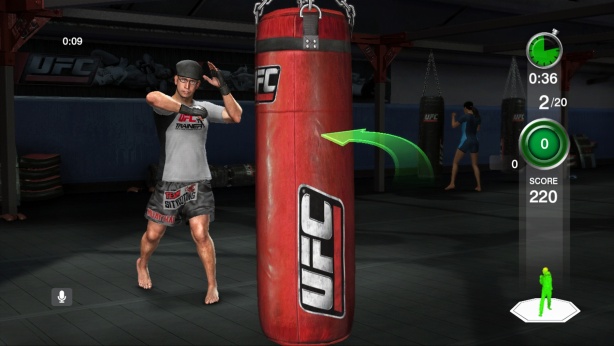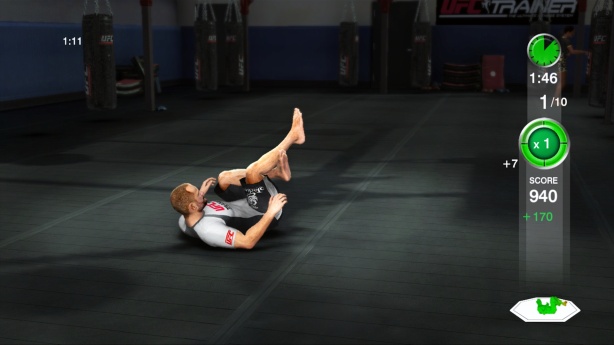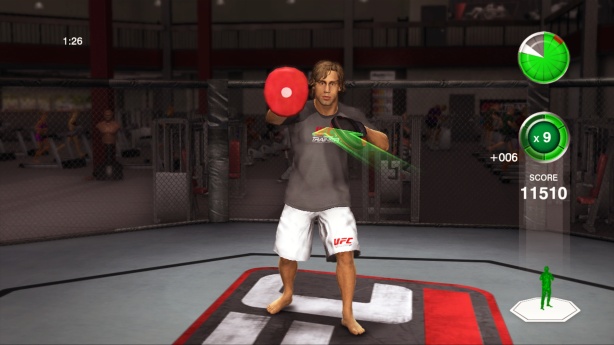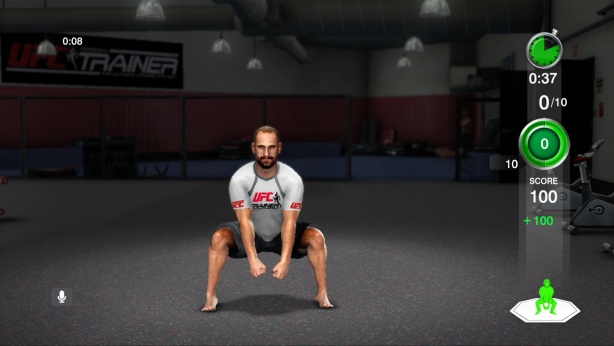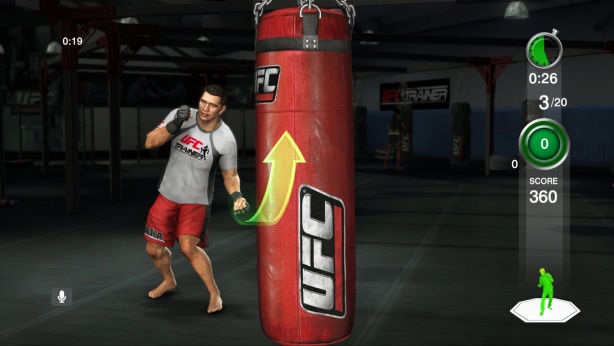UFC Personal Trainer Review
Developer: Heavy Iron Studios
Publisher: THQ
Available on: Xbox 360, PlayStation 3, Wii (Xbox Version Reviewed)
The advent of motion-controlled gaming has brought with it a slew of exercise and workout games. It began on the Nintendo Wii and has continued with the release of the PlayStation Move and Kinect. Whilst most of the available titles are quite niche, the genre sells well at a relatively low production cost. Just look at Zumba Fitness: fairly low production values, yet across all platforms it has been a chart-topper for weeks on end. The same was true of Wii Fit, which came complete with its own Balance Board.
However, THQ has now decided to extend its partnership deal with the Ultimate Fighting Championship in what must be an attempt to lure a new target audience for fitness games: men. Fitness videos and (to an extent) games have traditionally been mainly marketed at women, whether wisely or not. With UFC Personal Trainer, THQ are looking to attract both fans of the UFC who want to train like their favourite fighters, and other users (men and women) who may have been put off by previous “light” fitness games. This is fitness training with a fighting edge. But does it possess the fighting spirit to succeed?
STORY: There is no story as such, as you would expect from a game such as this. The background to the action is that you have the opportunity to train with some of the top trainers and fighters in the Ultimate Fighting Championship. This cage-fighting league is home to a variety of mixed martial artists, wrestlers and boxers, who fight across three to five rounds, with the objective of knocking out or submitting their opponent. To compete in the UFC, fighters need to be strong, in shape and resilient. UFC Personal Trainer offers a variety of different approaches and techniques to help users lose weight, build strength and improve their stamina.
GRAPHICS: Good graphics aren’t what people will immediately expect from a fitness game, but a well-presented package can make the game easier to navigate and more enjoyable. Since the game begins with full body scans of all of the real fighters and coaches involved, you know that there will be accurate character models and animation. This is important because you will be trying to copy a routine or exercise that has been performed on-screen, and if the model shown performs the manoeuvre correctly and in a natural way, the player can reproduce it safely. The only points of reference the user has for each exercise are those they see and hear, so the characters on-screen need to be clearly performing the moves in the correct way. Because the tutorials and instructions are presented so clearly, it is generally easy to replicate what you have seen.
The other side of the graphical equation is the presentation of information and data. The player is represented on-screen by a green Avatar, shown inside a UFC octagon. Stray outside the octagon (where you risk moving out of Kinect range) and the Avatar will turn first orange, then red, to indicate that tracking is becoming less accurate. This is also very clear, and allows the user to see whether they are performing the movements correctly, without the need for a mirror. Also, HUD icons and elements are fairly self-explanatory, and the screen never gets too cluttered with information that it becomes difficult to follow. Menu screens are all easily legible and buttons used for navigation are large and obvious. The navigation tools may not boast many bells and whistles, but the important elements are there and are clearly shown.
SOUND: Sound is something of a mixed bag. Hundreds of lines of dialogue have obviously been recorded for each trainer or training partner that you go through the routines with, and there are responses and comebacks to correspond with almost all levels of performance in an exercise. These can range from encouraging to disappointed, but will always make sense in the situation. Considering that you will be using this game almost every day (if you intend to follow some of the long-term programs) then you will of course start to hear repeated phrases quite soon. Whilst necessary at the beginning when new techniques are introduced, it won’t be long before you find yourself turning off trainer speech or just sticking to the subtitles, as the same old expressions will constantly roll off your coach’s tongue. There are only so many times you can hear the same lines.
Then there is the “motivational” music. This is generally one of two types of music: dramatic background music or “inspiring” Heavy Metal dirge. No matter how much you usually like Heavy Metal music, this game features only derivative, repetitive music that will soon become annoyingbecause it accompanies every activity. There is little to no variety in these tunes, and you would be forgiven for muting the TV set and listening to your MP3 or CD collection instead, as people would do at any normal gym. The menu music is also over-dramatic and uninspiring, and repeats ad nauseam. In all honestly, the game would be better off without it.
The feature that manages to be both the most impressive and the most irritating of the game is the voice control. Through the use of the Kinect directional microphone, users can quickly and easily navigate the in-game menus and move between exercises without the need to pick up the control pad or wave their hands around like a goon. Through the straightforward system of using words such as “trainer”, “pick one”, “previous screen” and “main menu”, the player can get from the start screen right into the action without moving their body at all. This does eliminate a lot of the frustrations of having to keep moving to pick up the control pad (losing Kinect recognition along the way) or having to hover your hands in mid-air, Minority Report style. This both speeds up and streamlines the experience.
However, the game doesn’t always recognise what you are saying. Although this is clearly the best use of voice control in a Kinect game so far, I had a lot of trouble getting the game to recognise the word “two”. Almost every other option was selected with ease, when I had to “pick two”, I was almost always unsuccessful. At other times, Kinect wouldn’t recognise the instructions if spoken too loudly, a fairly soft, regular spoken voice proved best in testing the feature. Another user who I asked to test the system couldn’t get the game to recognise their voice at all, so this system clearly still needs some refinement, although it does show the potential for completly controller-free navigation and control.
GAMEPLAY: The first thing to discuss is the Kinect body-tracking, and how it performs in-game. Aside from the warm-up stretching routines, all of your actions in UFC Personal Trainer will be tracked by your Xbox 360 Kinect camera. This is used to measure things like the accuracy of your punches or the number of sit-ups you have performed, and whether you have executed them correctly. Of course, if you don’t carry out the entire action required or you throw a wild punch, the game won’t count your action. Follow the instructions of your trainer and pull off a move in the correct way however, and it will be successfully ticked off against your list of objectives.
Be forewarned, you will most likely need to move furniture to play this game, as a large number of exercises are floor-based, so without the correct amount of room, Kinect won’t recognise your movements. Whilst this won’t make the game unplayable, reduced room will mean that the game will just estimate the number of reps or strikes you may perform, rather than counting what you really do. Make sure you are always shown as a green Avater in your octagon however, and you should be tracked fairly faithfully, although it won’t be tracked correctly every time. This happens more often with quick movements, or where several actions occur in a short space of time, such as jumping jacks or combination punches, but it is still a disappointment when it does, as your end of exercise score will reflect those misses. Luckily, missed actions don’t occur on a hugely regular basis, and most of the time you can complete a day’s workout routine with all of your actions being tracked as they should be.
The gameplay consists of three main areas: workouts, activities and programs. Workouts are individual exercises or a short series of different exercises put together and demonstrated by a particular trainer, complete with short tutorials to make sure you know how to successfully pull off each exercise. Complete the basic workouts and medium ones will unlock, complete medium ones in order to access hard ones, and so on. Workouts are each assigned difficulty ratings, so you can pick and choose ones to suit your current fitness level. You can even put together and save your own workout routines, hand-picking the different aspects or areas of the body you would like to focus on and selecting exercises on that basis. When performing most exercises, you will be scored and timed, and this performance will be recorded so that you can try to better yourself when you next perform the same exercise.
Activites are more of a series of one-off events, more focused on the fighting world of UFC than the more general fitness involved in the workouts. These are “Hit the Mitts”, where you follow the instructions of your trainer to throw a variety of strikes when prompted, “Free Striking”, which requires the user to continuously pummel a punch bag for a set period of time, “Speed Bag”, a more controlled activity based around finding a fast rhythm of punches and finally (the silliest of them all) “Tire Flip”, which is relatively self-explanatory.
Hit the Mitts will teach you how to throw a variety of punches, kicks, knees and elbow strikes, and measure your speed and accuracy in following the instructions the trainer barks at you. This mode to actually fighting, and as such, is probably the most fun and the one that feels least like a fitness title. The higher the difficulty level you reach, more variety is added in and combos become longer and more complex. Free Striking sees you up against the Heavy Bag in what is a test of endurance. Even on the lowest one minute setting, your arms are likely to tire a lot quicker than you imagine, and soon you will be kicking and throwing knees in order to give your arms a break. As well as producing an almost 1-to-1 representation of connecting with the punch bag on-screen, it reacts realistically to being hit and does at least give the impression that you are connecting with a real target.
Speed Bag is the most difficult, as it does require good timing and a certain degree of rhythm. You can easily go too fast or too slow, and finding the sweet spot whereby you can keep the bag moving smoothly requires quite some practice. Because this is all about finding a rhythm, the mode is fairly limited and there is no real progression or variety, other than trying to sink into a faster rhytm, without losing control of the bag. Finally, the Tire Flip is an extension of a squat: users must lift up an imaginary tire before rising to flip it upward. This mode suffers the most from the virtual prop, but with the addition of hand or wrist weights, a certain amount of resistance can be added to make it a more satisfying experience.
And finally, perhaps the jewel in the crown of the game (or at least the mode that will take up most of your time) the Programs. Players select either a 30 or 60-day workout, basing their choice on whether they want to cut weight, build endurance or build strength. The strength program will require the use of weights in order to see any real results, so will require an additional purchase. Players are then taken to a calendar screen which maps out their weekly timetable, which thankfully includes several rest days in each seven-day period. Each workout day can be viewed in advance, to see the exercises that the trainer has recommended for you. These focus on different areas of the body on different days, so as not to over-work a particular area. You cannot choose your off days or re-schedule a workout, so if you miss a day, you can’t go back to it. This will encourage users to keep coming back, so as not to get a black mark against their record.
These workout routines will last around twenty to thirty minutes, and consist of a combination of workouts and activities, buffered by stretches before and afterwards to decrease the chance of injury and stiffness. Stretches are un-moderated and not tracked by Kinect, but it is obvious to the user that if they don’t fully carry out the stretches, they will be at risk of being in a lot of pain after their workouts. During the workout, you will see total workout time, current activity time and your current scores, as well as being shown your previous best at the start of each routine, if you have performed the activity before. These all help you to measure your performances and to push yourself more in order to better yourself.
The Fitness Journal is the final piece of the puzzle, and is the total tool for following your progress through the game. You can view your achievements and medals, calories burned over the exercises, and your times, both overall and as an average. There is even a body map screen that will clearly show how the exercises you have performed are split between cardio, upper body, core and lower body. This helps you know which areas you have been focusing on more, and therefore the areas that you should spend more time working on.
LONGEVITY: The length of time you can spend playing this title is, ultimately, down to the individual. Motivation is always the hardest part of any fitness routine or plan and this game is no different. Whilst it is likely to get more people who are uninspired by the more sedate or “feminine” fitness titles interested, does it have enough to keep them coming back? There is a huge number of routines and activities to partake in, with further ones being unlocked as you progress further through your regimen.
The game will try to create an interesting mix of activies during a weekly program, but this is limited by the number of options available. But the game’s capacity to provide lengthy programs means that players will have an incentive to keep coming back, and I did feel bad on a day when I had to miss one of my workouts through time constraints. If a game can make you feel guilty about not playing it, it’s likely that you will want to return and keep trying out the different routines.
MULTIPLAYER: Multiplayer and online options are fairly perfunctory. You get most of the options that you would expect from a modern title, with little to make the experience one you will want to repeat often. A succession of different Leaderboards allows users to compare times and performance scores against either their friends list or the whole world, which will either result in a sense of pride or shame, depending on how you measure up against the rest.
There are both online and offline multiplayer options, with Speed Bag and Tire Flip available for side-by-side competitive action, and all three challenge modes available over Xbox LIVE. These are all fairly short mini-games and won’t really distract you for long, but it is a nice little bonus that will allow you to compare your mastery of each activity with your mates’. Now, what they need for the sequel is a head-to-head offline mode where two users compete to perform the most press-ups in a set time: that would be quite something to watch!
VERDICT: If you are personally motivated to improve your fitness, UFC Personal Trainer is a powerful and comprehensive tool that will help you meet your targets. It covers different areas of fitness and tries to wrap them up in a fighting package to make them more attractive, and (for the most part) it succeeds. The Kinect recognition, both physical and verbal, may not hit the mark one hundred percent of the time, but the tracking is pretty accurate and is more lenient than Your Shape: Fitness Evolved. It is, however, more finely tuned than the tracking seen in most dancing titles.
The main objective is to improve the fitness of its users, and the game never fails. Even if you don’t try very hard, the trainers will still give you encouragement and remain positive. If you do intend to use the title’s long-term programs, you are bound to start off a little rusty, but if you put in the required time and effort, you will find that it is a very good system for personal fitness. The focus may well be on cardio-vascular exercise over strength, but with the addition of some hand or ankle weights, the user really can tune the programs to fit their needs. After using this game, you won’t end up being able to fight like a pro, but hopefully your body will be just a little step closer to fight-fitness. UFC beware, we have a new fighter in training.


